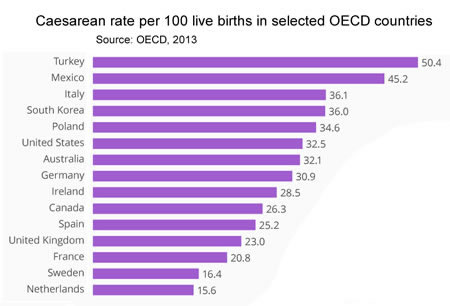
Are hospitals the best place to deliver a baby?
Caesarean sections causing narrower hips
Disadvantages of a high-tech hospital birth
Risks with Caesarean delivery
Advantages of a traditional birth
References
Caesarean sections causing narrower hips
A study (1) published in 2016 found that the regular use of Caesarean sections is rapidly altering one aspect of our evolution - many women now have a pelvis that is too narrow to deliver a baby. Caesarean surgery enables a safe delivery today, whereas in previous centuries both the mother and the baby would have died and so not passed on the genes for a narrow pelvis.
Researchers estimate that the number of women whose birth canal is too narrow for delivery has increased from 3% to 3.6% in the last fifty years, and this trend is likely to continue.
A typical USA hospital with a high-tech environment in 2016 charges about USD$30,000 for a normal delivery, including pre and post-natal care. Add USD$20,000 if a Caesarean section is used. You can see where the financial incentive lies, in addition to which the doctor gets another op on their CV and gets to conveniently schedule the C-section often days ahead and during office hours.

The financial incentive, convenience for all the staff, and administrative scheduling efficiency mean that C-sections are now routinely used when a vaginal birth could safely be done. In 2010 the WHO estimated that only 1% of births would have a serious outcome for the mother or baby if a C-section was not used. (2) In contrast, here are some actual rates of use:
Brazil has the highest rate in the world at 52%. The poorest countries in Africa, Asia and South America have rates ranging from 2% to 5%.
Disadvantages of a high-tech hospital birth
Increased risk of post-traumatic stress disorder, above the 2%-6% suffered by women giving a normal vaginal birth. (2)
More than half of all births in developed countries are "assisted" by being induced, using forceps, or surgery.
A 2012 Cochrane review on home versus hospital births confirmed that the rate of complications in hospital births is significantly higher, and found the main cause was "impatience and easy access to medical procedures". (6)
Risks with Caesarean delivery
- Loss of the initial inoculation with bacteria and other microorganisms which occurs during a vaginal birth. Many doctors are now waking up to this shortfall, and are using a swab to achieve the same effect.
- Complications in future pregnancies, including a higher chance of the placenta implanting or growing abnormally, or uterine rupture along the site of the C-section scar.
- Increased risk that all subsequent births will need to be done by C-section.
- Antibiotics are routinely used during surgery. Instead of a dose of essential bacteria from the mother, the baby gets antibiotics.
- Normal risks from surgery - infection, accidental damage to nerves or organs, haemorrhages, blood clots and so on.
- Breastfeeding less likely.
- Recovery after a C-section is usually longer than that of a vaginal birth. Women who have C-sections typically have six weeks of post-operation pain and bleeding compared to two to four weeks after a vaginal birth.
Advantages of a traditional birth
About 1% of women in the USA and 3% of women in the UK choose to have their birth at home.
Having the same caregiver with the mother throughout the birth reliably reduces pain, distress, complications, and the risk of any interventions including the need for painkiller drugs, epidurals, oxytocin, scissors, forceps or a C-section. Emotional support from the same trusted person reduces the mother's fear and stress and brings them back to a state of normality. The trusted caregiver is probably more open to the physical positioning and needs of the mother in labour. This can reduce pain and the need for painkillers. A meta-review showed that their labours are shorter, and their babies are born in better shape. (3)
In 2011, a British study of 65,000 women with low risk pregnancies found that those who started their deliveries at home had substantially better outcomes. They were less likely to require any drugs of any sort, less likely to be cut or torn or need forceps, less likely to need a C-section. Their babies were born in better shape, and they were more likely to breastfeed. The advantages remained even when they had to transfer to a hospital for pain relief or medical interventions. (4)
Another study of 9,000 women in the UK found that those with low risk and normal risk pregnancies who used an independent midwife working outside the NHS had a similar range of improved outcomes. 78% of them had unassisted deliveries, compared to 54% of women receiving conventional medical care. (5)
References
1. Philipp Mitteroecker, Simon M. Huttegger, Barbara Fischer, Mihaela Pavlicev.
Cliff-edge model of obstetric selection in humans.
PNAS, 5 December 2016, doi: 10.1073/pnas.1612410113.
2. Olde E, van der Hart O, Kleber R, van Son M.
Posttraumatic stress following childbirth: a review.
Clinical Psychology Review, 26 Jan 2006; 26: 1-16.
3. Hodnett ED, Gates S, Hofmeyr GJ, Sakala C, Weston J.
Continuous support for women during childbirth.
Cochrane Database of Systematic Reviews, 2011; issue 10, Article CD003766. doi: 10.1002/14651858.CD003766.pub3.
4. Brocklehurst Peter, et al.
Perinatal and maternal outcomes by planned place of birth for healthy women with low risk pregnancies: the Birthplace in England national prospective cohort study.
British Medical Journal, 2011; 343: d7400.
5. Andrew Symon, Clare Winter, Melanie Inkster, Peter T Donnan.
Outcomes for births booked under an independent midwife and births in NHS maternity units: matched comparison study.
British Medical Journal, 2009; 338: b2060.
6. Olsen O, Clausen JA.
Benefits and harms of planned hospital birth compared with planned home birth for low-risk pregnant women.
Cochrane Database of Systematic Reviews, 2012, issue 9. Art No CD000352.
